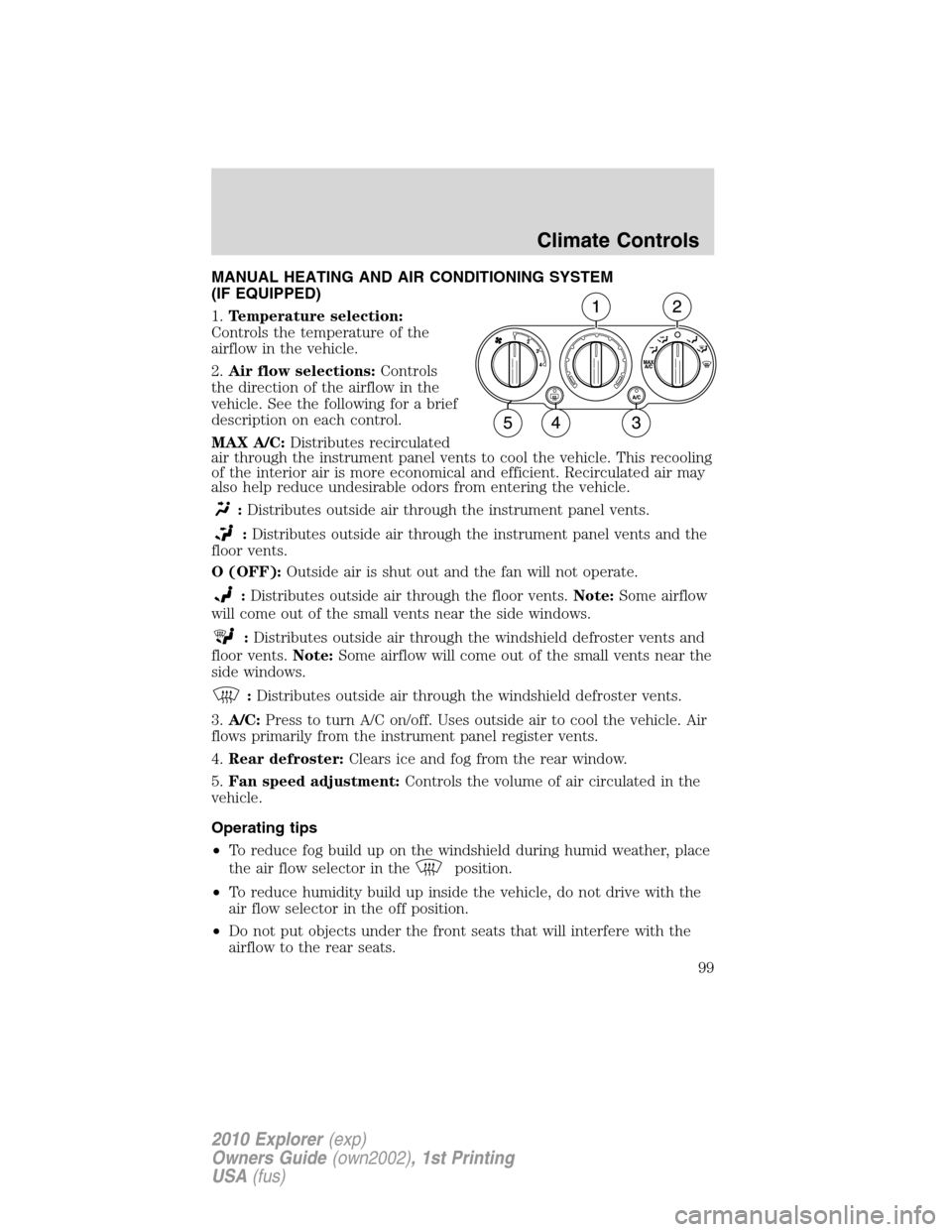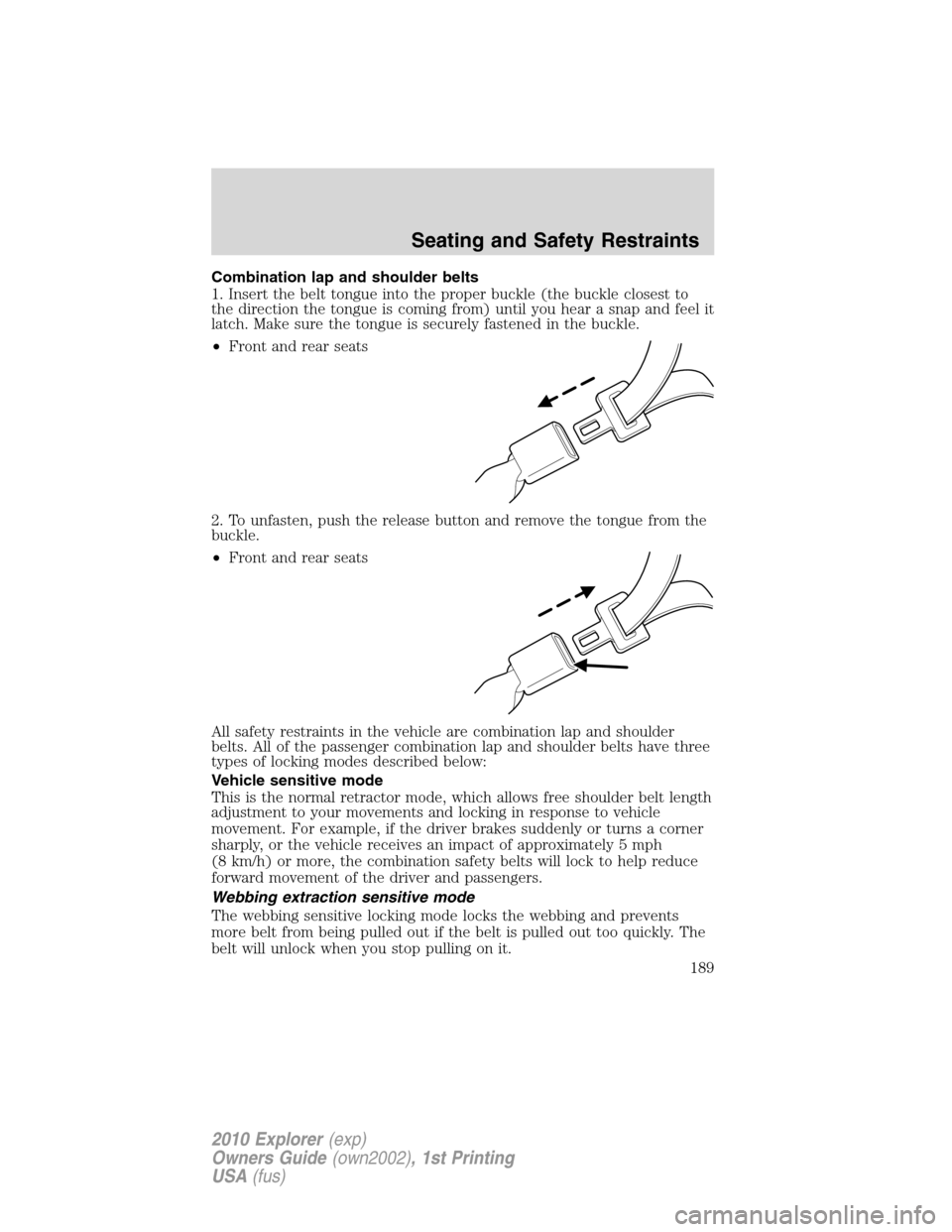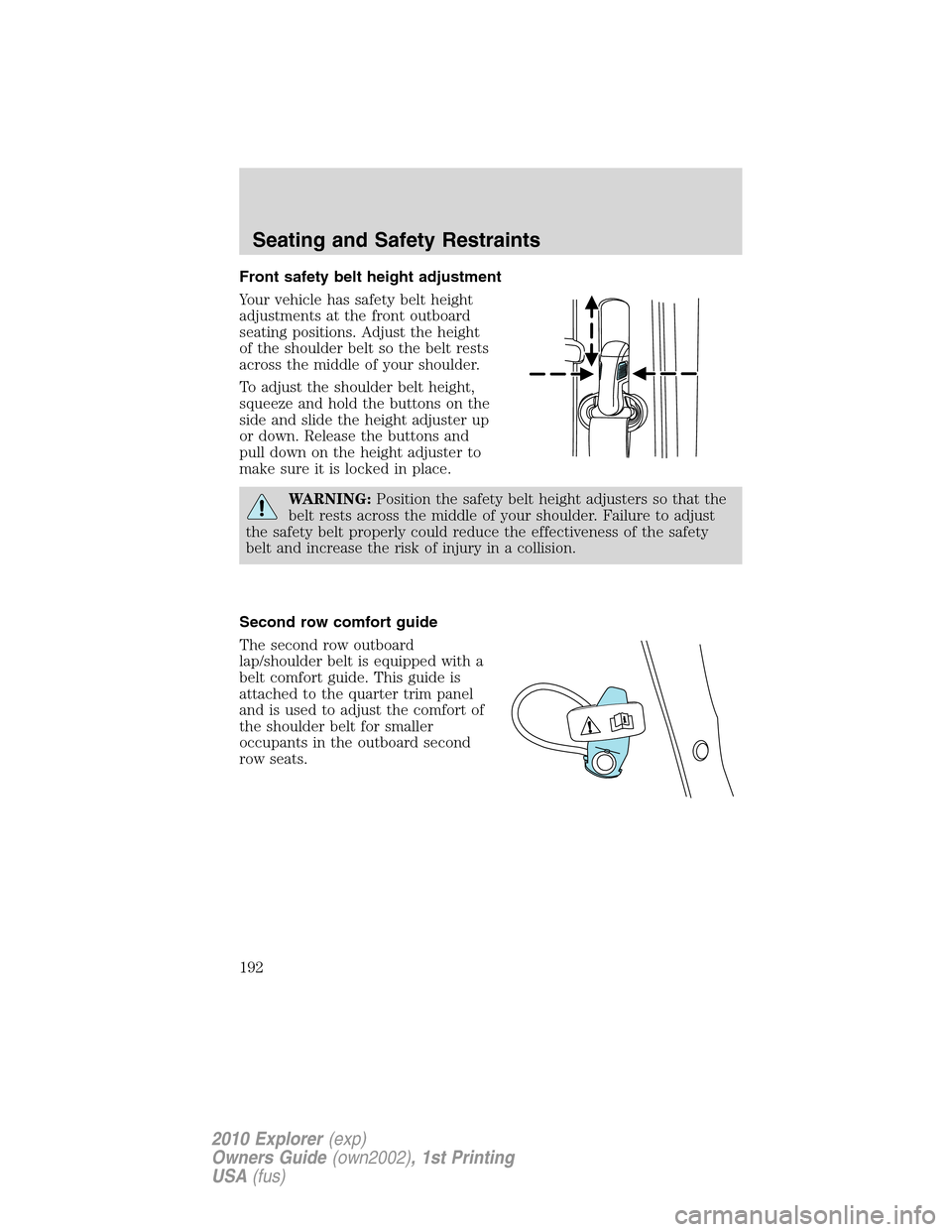2010 FORD EXPLORER seat adjustment
[x] Cancel search: seat adjustmentPage 5 of 404

Warning symbols on your vehicle
When you see this symbol, it is
imperative that you consult the
relevant section of this guide before
touching or attempting adjustment
of any kind.
Protecting the environment
We must all play our part in
protecting the environment. Correct
vehicle usage and the authorized
disposal of waste, cleaning and
lubrication materials are significant
steps towards this aim. Information in this respect is highlighted in this
guide with the tree symbol.
CALIFORNIA Proposition 65 Warning
WARNING:Engine exhaust, some of its constituents, and
certain vehicle components contain or emit chemicals known to
the State of California to cause cancer and birth defects or other
reproductive harm. In addition, certain fluids contained in vehicles and
certain products of component wear contain or emit chemicals known
to the State of California to cause cancer and birth defects or other
reproductive harm.
PERCHLORATE MATERIAL
Certain components of this vehicle such as airbag modules, seat belt
pretensioners, and button cell batteries may contain Perchlorate Material
– Special handling may apply for service or vehicle end of life disposal.
See www.dtsc.ca.gov/hazardouswaste/perchlorate.
BREAKING-IN YOUR VEHICLE
Your vehicle does not need an extensive break-in. Try not to drive
continuously at the same speed for the first 1,000 miles (1,600 km) of
new vehicle operation. Vary your speed frequently in order to give the
moving parts a chance to break in.
Drive your new vehicle at least 1,000 miles (1,600 km) before towing a
trailer. For more detailed information about towing a trailer, refer to
Trailer towingin theTires, Wheels and Loadingchapter.
Introduction
5
2010 Explorer(exp)
Owners Guide(own2002), 1st Printing
USA(fus)
Page 99 of 404

MANUAL HEATING AND AIR CONDITIONING SYSTEM
(IF EQUIPPED)
1.Temperature selection:
Controls the temperature of the
airflow in the vehicle.
2.Air flow selections:Controls
the direction of the airflow in the
vehicle. See the following for a brief
description on each control.
MAX A/C:Distributes recirculated
air through the instrument panel vents to cool the vehicle. This recooling
of the interior air is more economical and efficient. Recirculated air may
also help reduce undesirable odors from entering the vehicle.
:Distributes outside air through the instrument panel vents.
:Distributes outside air through the instrument panel vents and the
floor vents.
O (OFF):Outside air is shut out and the fan will not operate.
:Distributes outside air through the floor vents.Note:Some airflow
will come out of the small vents near the side windows.
:Distributes outside air through the windshield defroster vents and
floor vents.Note:Some airflow will come out of the small vents near the
side windows.
:Distributes outside air through the windshield defroster vents.
3.A/C:Press to turn A/C on/off. Uses outside air to cool the vehicle. Air
flows primarily from the instrument panel register vents.
4.Rear defroster:Clears ice and fog from the rear window.
5.Fan speed adjustment:Controls the volume of air circulated in the
vehicle.
Operating tips
•To reduce fog build up on the windshield during humid weather, place
the air flow selector in the
position.
•To reduce humidity build up inside the vehicle, do not drive with the
air flow selector in the off position.
•Do not put objects under the front seats that will interfere with the
airflow to the rear seats.
Climate Controls
99
2010 Explorer(exp)
Owners Guide(own2002), 1st Printing
USA(fus)
Page 168 of 404

To remove the adjustable head restraint, do the following:
1. Pull up the head restraint until it
reaches the highest adjustment
position.
2. Simultaneously press and hold
both the adjust/release button and
the unlock/remove button, then pull
up on the head restraint.
To reinstall the adjustable head restraint, do the following:
1. Insert the two stems into the
guide sleeve collars.
2. Push the head restraint down
until it locks.
Properly adjust the head restraint so that the top of the head restraint is
even with the top of your head and positioned as close as possible to the
back of your head. For occupants of extremely tall stature, adjust the
head restraint to its full up position.
Seating and Safety Restraints
168
2010 Explorer(exp)
Owners Guide(own2002), 1st Printing
USA(fus)
Page 189 of 404

Combination lap and shoulder belts
1. Insert the belt tongue into the proper buckle (the buckle closest to
the direction the tongue is coming from) until you hear a snap and feel it
latch. Make sure the tongue is securely fastened in the buckle.
•Front and rear seats
2. To unfasten, push the release button and remove the tongue from the
buckle.
•Front and rear seats
All safety restraints in the vehicle are combination lap and shoulder
belts. All of the passenger combination lap and shoulder belts have three
types of locking modes described below:
Vehicle sensitive mode
This is the normal retractor mode, which allows free shoulder belt length
adjustment to your movements and locking in response to vehicle
movement. For example, if the driver brakes suddenly or turns a corner
sharply, or the vehicle receives an impact of approximately 5 mph
(8 km/h) or more, the combination safety belts will lock to help reduce
forward movement of the driver and passengers.
Webbing extraction sensitive mode
The webbing sensitive locking mode locks the webbing and prevents
more belt from being pulled out if the belt is pulled out too quickly. The
belt will unlock when you stop pulling on it.
Seating and Safety Restraints
189
2010 Explorer(exp)
Owners Guide(own2002), 1st Printing
USA(fus)
Page 192 of 404

Front safety belt height adjustment
Your vehicle has safety belt height
adjustments at the front outboard
seating positions. Adjust the height
of the shoulder belt so the belt rests
across the middle of your shoulder.
To adjust the shoulder belt height,
squeeze and hold the buttons on the
side and slide the height adjuster up
or down. Release the buttons and
pull down on the height adjuster to
make sure it is locked in place.
WARNING:Position the safety belt height adjusters so that the
belt rests across the middle of your shoulder. Failure to adjust
the safety belt properly could reduce the effectiveness of the safety
belt and increase the risk of injury in a collision.
Second row comfort guide
The second row outboard
lap/shoulder belt is equipped with a
belt comfort guide. This guide is
attached to the quarter trim panel
and is used to adjust the comfort of
the shoulder belt for smaller
occupants in the outboard second
row seats.
Seating and Safety Restraints
192
2010 Explorer(exp)
Owners Guide(own2002), 1st Printing
USA(fus)
Page 399 of 404

Child safety seats - booster
seats ...........................................229
Cleaning your vehicle
engine compartment ..............342
instrument panel ....................344
interior .....................................345
plastic parts ............................343
washing ....................................340
waxing .....................................341
wheels ......................................341
wiper blades ............................343
Climate control (see Air
conditioning or Heating) ..........101
Clock adjust
6-CD in dash .............................52
AM/FM/CD .................................45
Compass, electronic
calibration .................................27
set zone adjustment ...........27, 36
Console ..............................120–121
overhead ..................................119
rear ..........................................121
Controls
power seat ...............................170
steering column ......................130
Coolant
checking and adding ..............361
refill capacities ................365, 385
specifications ..........................385
Cruise control
(see Speed control) ..................128
Customer Assistance ................305
Ford Extended Service
Plan ..........................................395
Getting assistance outside the
U.S. and Canada .....................337
Getting roadside assistance ...305
Getting the service you
need .........................................333Ordering additional owner’s
literature .................................338
Utilizing the
Mediation/Arbitration
Program ...................................337
D
Daytime running lamps
(see Lamps) ..............................107
Defrost
rear window ............................105
Dipstick
automatic transmission
fluid ..........................................380
engine oil .................................354
Driveline universal joint and
slip yoke ....................................382
Driving under special
conditions ..................291, 298, 302
sand .........................................300
snow and ice ...........................303
through water .................301, 304
Dual automatic temperature
control (DATC) .........................101
DVD system .................................66
E
Electronic message center ...21, 30
Emergencies, roadside
jump-starting ..........................325
running out of fuel .........325, 372
Emergency Flashers .................306
Emission control system ..........377
Engine ........................................390
cleaning ...................................342
coolant .....................................361
fail-safe cooling .......................366
Index
399
2010 Explorer(exp)
Owners Guide(own2002), 1st Printing
USA(fus)